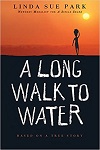|
A Long Walk to Water

Last updated Thursday, February 18, 2021
Author: Linda Sue Park
Date of Publication: 2010
ISBN: 0547251270
Grade Level: 5th (GLCs: Click here for grade level guidelines.)
Date(s) Used: Feb. 2021
Synopsis:
A Long Walk to Water begins as two stories, told in alternating sections, about two eleven-year-olds in Sudan, a girl in 2008 and a boy in 1985. The girl, Nya, is fetching water from a pond that is two hour's walk from her home: she makes two trips to the pond every day. The boy, Salva, becomes one of the "lost boys" of Sudan, refugees who cover the African continent on foot as they search for their families and for a safe place to stay. Enduring every hardship from loneliness to attack by armed rebels to contact with killer lions and crocodiles, Salva is a survivor, and his story goes on to intersect with Nya's in an astonishing and moving way.
| Note to readers: |
| • |
Some sensitive topics including death, war, abandonment, loss, displacement.
|
| • |
Story influenced by Second Sudanese War, characterized by decolonization along with an unequal transfer of power, resource disputes, and tribal conflict.
|
| Discussion topics for before reading: |
| • |
Ask everyone to think about how many different places they can access clean water.
|
| • |
Ask students to gauge how long it takes to obtain water. Seconds? Minutes?
|
| • |
Ask the class to come up with reasons why some water isn't safe to drink from (public fountains, reclaimed irrigation).
Vocabulary
|
| • |
monotonous (p. 73) - tediously uniform, unvarying
|
| • |
emaciated (p. 105) - very thin and feeble especially from a lack of nutrition or illness
|
| • |
din (p. 117) - a loud continued noise
|
| • |
shanty (p. 155) - a small crudely built dwelling or shelter usually of wood
|
| • |
scything (p. 157) - cutting as if with a scythe
|
| Discussion topics for during/after reading: |
| • |
Do you have any emergency plans that you've rehearsed with your family?
|
| • |
Why is Uncle's recommendation (p.85) to Salva helpful? Can you think of a time when you had a big task that you struggled to finish?
|
| • |
Why do you think the dry/wet seasons help contribute to the territory disputes over resources?
|
| Special activities: |
| • |
Create found poetry during reading (select excerpts from the text to combine).
|
| • |
Guess the drawing! Using MS Paint or equivalent, have the Reader screen share a digital drawing they create in front of the students as related to the material (beehive, giraffe, water well, geography: Sudan, Ethiopia, Kenya).
|
*Note: These craft ideas are just suggestions.
You can use them, but you don't have to use them.
You can expand upon them, or add your own twist.
Remember, though, that the focus of your time should
not be on the development and execution of a craft;
the focus should be on the read-aloud and the
enjoyment of the book!
|
